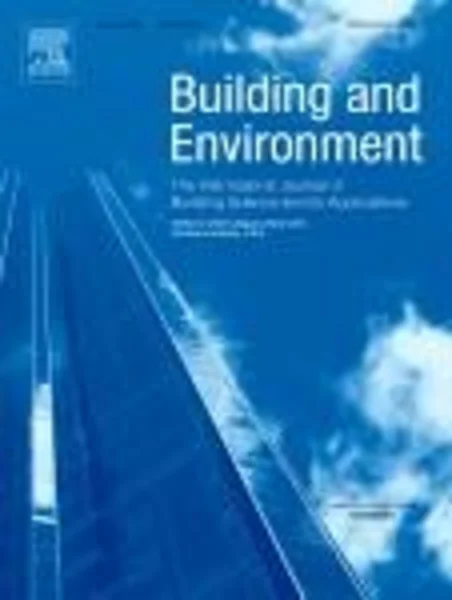-
transient buoyancy-driven ventilation: part 1. modelling advection
جزئیات بیشتر مقاله- تاریخ ارائه: 1390/01/01
- تاریخ انتشار در تی پی بین: 1390/01/01
- تعداد بازدید: 798
- تعداد پرسش و پاسخ ها: 0
- شماره تماس دبیرخانه رویداد: -
the unsteady development of the vertical temperature profile in a ventilated space containing a heat source is modelled. the buoyant fluid released from the heat source is modelled as a turbulent buoyant plume, using a standard integral plume model with a fixed entrainment coefficient. two types of natural ventilation flow are considered, with the flow driven entirely by the density contrast between the fluid inside and outside the space (stack effect). the ventilation types are (a) classic displacement ventilation, with outflow of warm air through upper openings and inflow of cool air through lower openings; and (b) doorway ventilation, with an exchange flow through the doorway. an improved version of the doorway exchange flow model is given as compared to previous studies. the boundaries of the space are considered to be perfectly insulating, so that heat is transported entirely by the fluid motion. the temporal stratification that develops within the space (outside the plume) is calculated using a modified filling-box model, with successive layers added to the top of the space over time. laboratory experiments giving reduced-scale simulations of the flows were also conducted, where saline solution and fresh water are used to model fluid of different density. the developing density profiles in the laboratory experiments compare very well with the model predictions. the use of this type of model, capturing the main physical flow features, allows rapid and accurate calculations of transient stratification in ventilated spaces.
مقالات جدیدترین رویدادها
-
استفاده از تحلیل اهمیت-عملکرد در ارائه الگوی مدیریت خلاقیت سازمانی و ارائه راهکار جهت بهبود
-
بررسی تاثیر ارزش وجوه نقد مازاد بر ساختار سرمایه شرکت های پذیرفته شده در بورس اوراق بهادار تهران
-
بررسی تأثیر سطح افشای ریسک بر قرارداد بدهی شرکت های پذیرفته شده در بورس اوراق بهادار تهران
-
بررسی تأثیر رتبه بندی اعتباری مبتنی بر مدل امتیاز بازار نوظهور بر نقد شوندگی سهام با تأکید بر خصوصی سازی شرکت ها
-
تأثیر آمیخته بازاریابی پوشاک ایرانی بر تصویر ذهنی مشتری پوشاک ایرانی (هاکوپیان)
-
نگرشی بر چگونگی خلاقیت کودک با رویکرد بیومیمیتکس
-
بررسی تأثیر دعا بر بینش نیایشگر از نظر شیعه و کاتولیک
-
نانو مواد و ساختمان سازی های هوشمند
-
تنش برشی متوسط کف و دیواره ها در جداره ی صاف کانال ذوزنقه ای با بهترین مقطع هیدرولیکی با استفاده از نگاشت همدیسی
-
optimization of critical factors to enhance polyhydroxyalkanoates (pha) synthesis by mixed culture using taguchi design of experimental methodology
مقالات جدیدترین ژورنال ها
-
مدیریت و بررسی افسردگی دانش آموزان دختر مقطع متوسطه دوم در دروان کرونا در شهرستان دزفول
-
مدیریت و بررسی خرد سیاسی در اندیشه ی فردوسی در ادب ایران
-
واکاوی و مدیریت توصیفی قلمدان(جاکلیدی)ضریح در موزه آستان قدس رضوی
-
بررسی تاثیر خلاقیت، دانش و انگیزه کارکنان بر پیشنهادات نوآورانه کارکنان ( مورد مطالعه: هتل های 3 و 4 ستاره استان کرمان)
-
بررسی تاثیر کیفیت سیستم های اطلاعاتی بر تصمیم گیری موفق در شرکتهای تولیدی استان اصفهان (مورد مطالعه: مدیران شرکتهای تولیدی استان اصفهان)
-
آسیب شناسی کیفرگذاری موجود در جرایم خانوادگی موضوع کتاب پنجم قانون مجازات اسلامی ( تعزیرات ) مصوب 1375 ؛ از تبیین آسیب ها تا ارائه راهکارها
-
مطالعه تحلیلی نقش مایه های دارایی بافی یزد از منظر نشانه شناسی
-
بررسی عوامل تاثیر گذار بر تمایل به ادامه کسب و کار اینترنتی در بنگاه های کوچک و متوسط استان تهران
-
آراء بلاغی فخر رازی در جزء اول قران کریم
-
studies on some mechanical properties of pvc-wood fibre composite




سوال خود را در مورد این مقاله مطرح نمایید :